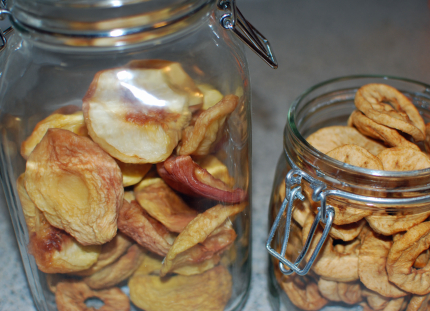
Like my melon colored kitchen in the photo above? I LOVE it!
I also love dehydrated foods. Drying foods is a great way to preserve local and seasonal foods and make it available for the remainder of the year. In fact I much prefer dehydration to canning because not only are you preserving the food, you are leaving it structurally and nutritionally in tact. When you cook a food you are changing the composition of it AND you are destroying as much as 50-80% of the nutritional value it once held. If you want hard data on exactly why raw and unprocessed is MUCH healthier than cooked read, The Live Food Factor. This book documents nearly 70 scientific studies done on the raw versus cooked debate. Most of them are listed alphabetically in an appendix so you can browse the scientific proof in the raw pudding one tantalizing detail at a time. Most raw food books are short on the science but not this one!
Canning food may preserve it but the food loses something in the translation. Dehydration preserves the food AND the nutritional content with one caveat… it must be dried at low temperatures. Most of the dehydrators you see in stores do not have temperature controls or air flow so I knew I would need one that did. I also selected a brand that many raw foodists have used and endorsed. I chose a 5 tray Excalibur dehydrator to use in my home. For larger families and dehydration requirements there is a nine tray model too.
This is the only dehydrator I have used so I cannot make comparisons but this smaller Nesco one is cheaper and it does have air flow and temperature controls… so if you are on a strict budget you may want to look into it.

Primarily we use our dehydrator to make dried fruit and veggie snacks, fruit leathers, dried nuts, nut flours, raw cookies, and more. Now that apple season is upon us it is time to get busy making bunches of dried apple slices… just as it was for peaches a few weeks back. Local food goes further to nourish your family with a dehydrator. Healthy snacks and lunches are MUCH easier to pack when you have dehydrated goodies on hand. Camping and hiking trips are easier to plan to.
I like the fact that the temperature controls allow me to get the food super crispy if I want or slightly moist if I want… aka crispy banana chips but slightly moist apricot slices.

Even if you don’t eat raw, a dehydrator can still be wonderfully useful. I recently read Backpack Gourmet by Linda Frederick Yaffe and it has tons of great recipes for dehydrated foods. It also has some clever complete meal ideas. They are light weight, fast, full meals that will keep your energy up. Instead of packing in heavy foods that you have to prepare at camp you can make the meal at home and then dehydrate. Then when you are on your trip all you have to do is add water and voila!

It has recipes for casseroles, pastas, soups, chilis, stews, chowders, cereals, and much more. Imagine making a tasty bean and vegetable stew at home and then just spreading it out on your dehydrator sheet to dry overnight. The reduced water content makes it light weight and it retains the flavor and nutrition it had at home. Because it is pre-cooked you are only heating. This book is genius… lasagna while camping? Very cool. The recipes would be great for taking on vacation too. If you have a teeny hotel kitchen you can make a delicious meal in minutes and a small box of dehydrated dishes could easily equal a week or more of quality meals.
You can also use this nifty machine to dry leaves, fruit, herbs, and spices for homemade potpourri. Maybe now is the time to make some homemade holiday potpourri?

Do you have a dehydrator? Do you use it?

